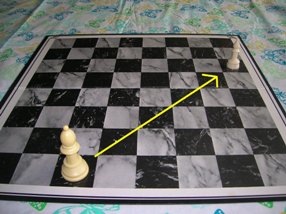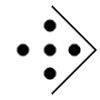Chess is an ancient game with many variations. The earliest known reference to the game is from a story written in India prior to 600 AD (Parlett 278). The version of it that is popular today was played during the tenth century by Vikings. There are written rules for Chess from the late 1200s that still exist. During the Middle Ages, it was mainly popular among the nobility, who considered it excellent practice for planning battle strategy. The names and types of the pieces show the character of their society with only one king and queen, a few elite clergy (seen on the board as bishops), knights, castles (called rooks), and many peasants (or pawns) who would make up the largest section of a Medieval army. As in Medieval warfare, the peasants (pawns) are typically the first to charge into battle followed by the knights and other special forces (Diehl and Donnelly 69). There are some minor differences between how Chess is played today and how it was played during the Middle Ages. First, I'll describe the modern rules, then I'll explain the slight differences between Medieval and modern chess.
Modern Chess
Players: 2
Time: Chess is not a quick game. Depending upon the skill and thoughtfulness of the players, games can last for hours. Yours may not last that long, but allow plenty of time to play or leave your game in a place where you can finish it later if you have to.
Object: To capture your opponent's king before your opponent captures yours.
Equipment: Chess board and two set of Chess pieces in different colors (not provided here because Chess sets are so commonly available, if you'd like to improvise a set you can draw the board as described below and use pieces of paper with the names of Chess pieces written on them)
Chess has very complex strategies, so here I'll simply describe the pieces and their basic moves and the proper way to set up a board. I used Games of the World, edited by Frederic V. Grunfeld (pp. 68-69) and the Instructions for Playing Chess included with the Family Classics game set by the Pressman Toy Corp., which agree with each other on most points, although there are a couple of minor differences, such as the method of counting of moves for the knight. The board is a square made up of smaller squares, 8 squares by 8 squares, of alternating colors, usually black and white. The pieces are black and white also. One player uses the black set of pieces, and the other uses the white ones.
The Pieces
The pictures below show the different pieces with arrows indicating how they can move. To help you better understand the moves, I've used additional pieces of the same kind to show where the different pieces start and stop on a move. The larger pieces show where the piece starts, and the smaller pieces show where the piece can stop. The pictures do not show all the possible moves a piece can make, they are just examples. The descriptions for each piece will give you more information.
King: Although this is the piece upon which the entire game depends, his moves are rather limited. He can move in any direction (forward, backward, right, left, or diagonally), but he can only move one square at a time. If your opponent is in a position to capture your king on his next turn (this is called "check"), you must move the king out of danger or capture or block the threatening piece on your turn to bring the king out of check. If you can't, it's called "check mate", and the game ends (see below).
Queen: Like the king, the queen can move in any direction (forward, backward, right, left, or diagonally), but she can move up to seven spaces at a time (the length of the board, not counting the space where she starts) as long as there is no other piece blocking her way. If there is, she may capture it and stand on its space.

Bishop: The bishop moves diagonally (and can move in a backwards diagonal as well as forward diagonal), up to seven spaces at a time, and may capture any piece in its path, stopping on the square where it makes the capture.
Knight: The knight moves on a crooked path, one space straight (either forward, backward, or to the side) and one space diagonally (Grunfeld 69). Some people prefer to count it as two spaces straight and one to the side (in either direction) ("Instructions for Playing Chess"), but it amounts to the same thing. If you study the board, you can see that with either method of counting, the piece would still end up the same space. Unlike the other chess pieces, the knight jumps over other pieces in its path. It captures any piece on the square it finally lands on.
Rook: The rook moves in a straight line (it can go forward, backward, right or left), up to seven spaces at a time, and may capture any piece in its path, stopping on the square where it makes the capture.
Pawn: Pawns can only move in one direction: forward. They move straight forward, one space at a time, except on their first move, when they can move two. However, they cannot make a capture by moving forward; all captures must be made by moving one space diagonally. If a pawn comes up against another piece, it will be unable to move at all until either the other piece moves out of its path or it becomes possible for the pawn to make a capture, allowing it to move one space diagonally. Any pawn which succeeds in making it all the way to the other side of the board may be traded for any more powerful piece that your opponent captured earlier (except a king, of course, because the capture of the king automatically ends the game).
The Game
Set up of the board should look like this:
The two sides should mirror each other. White always moves first.
Check: If you are in a position to capture your opponent's king on your next turn, you must tell him so that he has a chance to block the attack, move his king, or capture the threatening piece, if he can. If he can't, it is called "checkmate," and the game ends.
Checkmate and Winning: The game is over when one of you cannot block or prevent your king from being attacked or move your king to any space where he will be safe from capture ("checkmate"). You can concede the game and declare your opponent the winner if you are in a position where your king is the only piece you have left on the board and your only move is go back and forth to keep yourself from check. No matter who wins, the two of you should shake hands and congratulate each other on a game well-played. Manners count.
Medieval Variation
During the Middle Ages, the rules of the game were slightly different from modern times. Queens could only move one space diagonally, and bishops only two spaces diagonally. Pawns could only move one space per turn and, upon reaching the other side of the board, could only be exchanged for queens (Parlett 302).
Also, red and white were the most popular colors for the board and pieces, although blue, black, or other colors could be substituted for red (Parlett 302). (Remember the colors of the chess pieces in the sequel to Alice in Wonderland, Through the Looking Glass by Lewis Carroll? Red was a popular color for chess pieces for a long time.)
On special occasions, Medieval people might play a life-size version of the game with people in costumes acting the part of the pieces on a floor made to look like a game board (Cosman 55).

